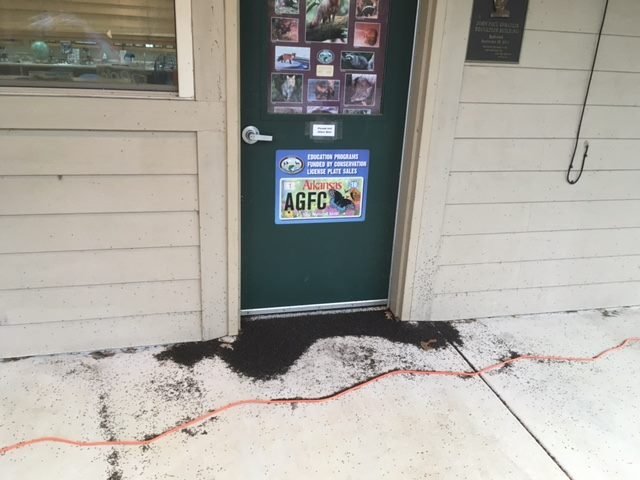An education center that had closed because of a scourge of buffalo gnats has reopened, but livestock and deer continue to succumb to the swarming insects, state officials said Tuesday.
Heavy winter rains generated flash floods that invited the gnats to lay eggs in flowing waters that broke away from the normal river channels. Those eggs started hatching in the past week or two with the beginning of spring and moderate weather, and the gnats have clustered around homes and on farms in flood plains in the east-central Delta.
Kelly Loftin, a state entomologist and professor with the University of Arkansas System Agriculture Division's Cooperative Extension Service, said this year's breakout of gnats is much worse than a typical year.
"I would say in my 20 years with Extension, with the university, it's the worst I've seen," Loftin said.
Gnats lay eggs in the late winter and spring that can remain viable for years, Loftin said, so many more might hatch next spring. Gnat eggs hatch only once each year.
An abundance of gnats forced the Arkansas Game and Fish Commission to close the Potlatch Conservation Education Center at Cook's Lake, about 18 miles east of Stuttgart in Arkansas County. The commission announced the closure Thursday with photographs of a pile of gnats clustered on the center's front porch, resembling scattered dirt. In one place, a solid half of a welcome mat was covered by gnats.
Game and Fish spokesman Keith Stephens said the agency reopened the center Tuesday morning.
Extension services in Arkansas, Prairie and Lonoke counties and other areas have received calls from people looking for ways to combat the infestation of gnats.
The influx has led to deaths of cattle, horses and deer, according to Loftin. Gnats can fly into an animal's throat and cause swelling and constriction of its airway, said Keith Perkins, Lonoke County Extension Service staff chairman.
One farmer said he found seven dead deer Monday on his 3,000-acre property, said Phil Horton, county agent for the Arkansas County Extension office.
Horton said a lot of deer also are getting run over because they are on the move, trying to escape the gnats. He said he found a deer taking cover in the carport of his residence in the eastern part of the county near the White River.
Gnats are a nuisance to people, too.
Rhonda Humphries, an administrative assistant with the Rice Research and Extension in Arkansas County, said this is the worst year she can remember for gnats.
"We've got so many gnats coming around, you just don't want to go outside," she said.
Horton said he's staying inside as much as he can, too.
"They're terrible," he said. "If you swat across the front of your face, you'll hit numerous [gnats]."
People can protect their animals by moving livestock to areas where there aren't as many gnats or by sheltering animals.
"The flies won't enter buildings or barns," Loftin said.
People also can use insecticides that contain permethrin to protect animals and themselves. Some are for animal use only, while others are only to be used on clothing and are not intended for contact with human skin. Repellents that contain geraniol, picaridin or IR3535 also work well for humans, according to the Extension Service.
People are encouraged to wear bright colors, long sleeves and long pants to avoid gnats attaching themselves to their skin. Wearing hats with screens can protect airways.
As a last resort, hay bales can be burned to cause dark smoke that deters gnats, Loftin said.
Loftin said he hopes the gnats will decline in about a week, but it will depend on whether temperatures rise enough to discourage hatching. Two or three days with temperatures of 80 degrees or higher should make a big difference, he said.
Extended forecasts through Friday don't show any days nearing 80 degrees in those areas, according to the National Weather Service, although temperatures neared that Tuesday.
Perkins said he expects gnat numbers to peak soon before declining and disappearing within the next few weeks.
Metro on 04/04/2018

